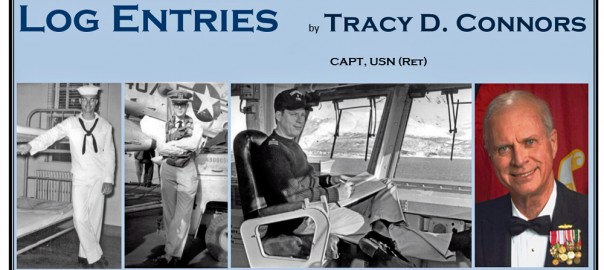Engaging in Soot-bat

I would have to wait until about 18 months later to “defend freedom” during the Cold War. It was not to be combat, but was more along the lines of soot-bat.
Even at sea, the winds could be light in the Mediterranean, especially during the summer or early autumn. Typically, our operations orders specified what area we were to stay within during our daily air operations and exercises. Launching and recovering operations required at least 30 kn of wind down the deck to ensure there was enough wind velocity for aircraft safety. When winds were light, we would need to maintain 25 kn – or even more – for at least half an hour. Launching 15 or 20 aircraft, and recovering an equal number, would require that long – or longer.
Since the wind, however slight, would typically come from the same general direction for a period of time, running up wind would take us 15 to 20 miles in that direction. Unless we reversed course and went back downwind between launches and recoveries, we would soon find ourselves far beyond our assigned operating area.
This explains, why in a given period of time, our ship would run up wind at high speed for half an hour or so launching aircraft, then reverse course and run downwind at not so great a speed so as to save fuel and wear and tear on the machinery, but attempt to remain in the same general location.

This pattern of operation, made it relatively easy for the Soviet “trawlers” that were constantly shadowing us to keep us within their electronic reception range even though our speeds were considerably greater than theirs.
© Copyright 2017-2022 BelleAire Press
Other works by Dr. Connors…
Baited Trap, the Ambush of Mission 1890
Now Available As E-Pub

Baited Trap, The Ambush of Mission 1890 is the story of helicopter rescue Mission 1890, one of the most heroic—and costly—air rescues of the Korean War. This harrowing Air Force-Navy mission is explained in compelling detail, creating a detailed personal account of what five incredibly brave and determined Air Force and Navy airmen achieved on June 25, 1952 in the infamous “Iron Triangle.”
The Korean War’s Greatest Love Story
Baited Trap is much more than a heroic war story from the “forgotten war.” It is also the Korean War’s greatest love story, following Wayne and Della Lear, Bobby Holloway, Ron Eaton and Dolly Sharp, and Frankie and Archie Connors as they tried to put their lives and families together even as the Korean War was reaching out to engulf them.
Truckbusters From Dogpatch: the Combat Diary of the 18th Fighter-Bomber Wing in the Korean War, 1950-1953

Truckbusters from Dogpatch is the most comprehensive Korean War unit history yet prepared–over 700 pages summarizing squadron histories and first person accounts—and includes over 1,000 never before published photographs and images, highlighted by the 8 ½ x 11-inch format.
Arguably, Truckbusters From Dogpatch is the most authoritative unit history ever prepared on the Korean War. In addition to consulting formerly classified squadron histories filed monthly throughout the conflict, the author was in touch with hundreds of veterans of the 18th—pilots and ground crew—whose personal recollections add vivid detail and emotion to the facts recounted in the official documents.
Recent Log Entries by CAPT Connors…
Carrier Captain’s Night Orders: “Call Me…”
After reading these Night Orders you can better appreciate what training, attention to duty, and vigilance was required by underway watchstanders in those days. What has changed since then that has resulted in the recent tragic collisions between U.S. Navy ships and other vessels?
“We do it all!” (USS Saipan LHA-2 motto)
Saipan CO, CAPT Jack Renard, was not exaggerating when he noted that “without exception, SAIPAN is the most versatile instrument of peace or war on the seas today.” Like its motto pointed out, SAIPAN could do it all.
